Fusion leaps ahead in styling, technology
By John Gilbert
SANTA MONICA, CALIF. — There is no ring hovering above the roof of the 2013 Ford Fusion, but there might as well be, because the completely revised midsize sedan clearly is Ford Motor Company’s the new “halo” vehicle. Ford has impressively redone its vast array of models, most of them over the past year or two, and as impressive as they are, they must fall in line behind the 2013 Ford Fusion.
The new Fusion might be the best and best-looking car ever turned out in Detroit, although General Motors and Chrysler loyalists would strongly argue. But while styling and beauty are definitely subjective, anyone finding fault with the new Fusion’s looks are welcome to raise their hand. The grille and front end resemble the exotic Aston Martin; the sloping rear window and “C” pillars blend into its tail similar to a German Audi A7 sports sedan; and the side offers a thoroughly modern silhouette not unlike an Acura TL of a previous generation. That’s a pretty impressive hat trick from which to draw comparisons.
Ford not only brings those appealing style elements together, it fills the Fusion with enough technology and features that its captivating appearance almost become secondary. Four new engines — and not a V6 among them — take up residence under the Fusion hood, and carry their share of the load, with the largest of the four being the most docile, with tricks such as turbocharging, new hybrid technology, all-wheel drive, plus four transmissions, are all available.
The Fusion already has carved a solid position in the midsize category, which is more competitive than ever, with new models of the Honda Accord, Nissan Altima, and Chevrolet Malibu, with more to come, plus stalwarts like the Toyota Camry, Hyundai Sonata, Kia Optima, and Volkswagen Passat redone in the last year or two. But the new Fusion lives up to nearly a full year of pre-introduction hype and hits the market well-prepared for the battles ahead.
Waves of journalists were brought to Los Angeles, and delivered up the coast to the Casa del Mar, a fancy resort hotel that opens out onto Santa Monica’s legendary beach. Actually, our first stop was three blocks up the street, where we saw a fleet of Fusions parked awaiting us. It was the first time we’d seen the car except on static displays at all of this past year’s auto shows and other major automotive events. But these were ready to move, and they were all hybrids.
In the Fusion scheme of things, a group of 4-cylinder engines gain appreciably from the emergence of EcoBoost technology, which is turbocharging smaller engines to make them respond like larger engines when prodded, but deliver smaller-engine fuel efficiency. The car has 4-cylinder engines with displacement ranging from 1.6 liters, to 2.0, and up to 2.5. Ironically, the 2.5 is the largest, but with no turbocharger and no hybrid boost it is the least powerful, although it can still attain 175 horsepower and an identical 175 foot-pounds of torque — both solid numbers in the midst of the midsizers.
The 2.5 is the standard engine in the basic “S” model Fusion, which has EPA fuel economy estimates of 22 city, 34 highway, and starts at a base price of $21,700. The SE is next, with a base starting at $23,700, with the SE Hybrid starting at $27,200, and the top of the line Titanium starting at $30,200.
Ford has set it up so buyers can choose optional engines and features form the option list in any model. The SE runs strong with an amazing little 1.6-liter EcoBoost engine, with EcoBoost being Ford’s name for its direct-injection and turbocharged technology. The turbo pushes the little 1.6 to 178 horsepower at 5,700 RPMs, with a 184-foot-pound supply of torque at a mere 2,500 RPMs, and EPA estimate of 22-34 miles per gallon.
The 2.0-liter EcoBoost 4 has similar EPA estimates (22 city, 33 highway), but kicks the power up to 240 horses at 5,500 RPMs and 270 foot-pounds of torque at 3,000 revs. Ford offers two numbers for both EcoBoost 4s, suggesting that if owners choose to use regular fuel the horsepower in the 1.6 is reduced from 178 to 171, and in the 2.0 it drops from 240 to 231. Premium fuel undeniably makes the engine perform a bit better, but it’s breakthrough engineering to build an engine that will also run on regular fuel, which can be priced at 20 cents or more under premium, and, at nearly $4 per gallon, can make a large difference at fill-up time.
The Fusion is 191.8 inches long, on a 112.2-inch wheelbase, with a height of only 58.2 and a width of 72.9 inches. It will seat five, but four are much more comfortable, with rearseat headroom of 37.8 inches, and legroom of 38.3. Cargo volume is 16 cubic feet, and total passenger volume is 102.8 cubic feet. The car weighs from 3,333 to 3,681 pounds depending on the model, and it’s one of those contemporary midsize cars that make you wonder why anything larger is necessary.
The EcoBoost engines were still awaiting us on the twisting mountain roads up into the mountains from the Santa Monica shoreline, but first, we were immersed into driving the hybrid, and it was a completely different animal.
The Fusion Hybrid starts with a 2.0 that has the same displacement as the other Fusion 2.0 engines, but is revised with the Atkinson-cycle valve timing which holds the valves open longer to promote more complete burning of the fuel-air mixture. That drops the engine’s power to 141 horsepower with 129 foot-pounds of torque, which is still an improvement over the previous 2.5 used in the current Fusion Hybrid. Ford had adopted the newest lithium-ion battery pack, which is about 25 percent smaller and 50 percent lighter than the old Fusion Hybrid’s battery layout, but it gains power and holds a charge longer.
Combining the two gives the Fusion Hybrid 188 horsepower, and it gives the car the chance to drive up to 62 miles per hour on pure-electric power, up from a maximum of 47 mph with the previous power combination. The new Fusion Hybrid also has EPA estimates of 47 miles per gallon for both city and highway driving, which, Ford quickly points out, is 4 mpg better than the Toyota Camry Hybrid in city driving, and 8 mpg better in highway driving.
I drove the Fusion Hybrid around a planned course, along the Malibu beach briefly, then back around into the city. It was a short loop, and I had carefully zeroed the odometer, but after my drive the computer indicated only 39 mpg, and I knew I had driven more delicately than that. Sure enough, the mpg computer hadn’t been zeroed, just the odometer. So we located another screen showing vertical bars in 15-minute batches. Whoever had been driving earlier must have been one of those “traditional” media types who insist on driving hybrids as hard as they drive normal engines to evaluate performance, while ignoring fuel economy. I prefer to drive a vehicle the way it’s intended, and my driving included the last two vertical bars, which indicated 60 mpg.
Power and pep were more than sufficient, and the Fusion handled its city driving easily. Another key ingredient of the best hybrids is the use of regenerative braking, which uses its energy from decelerating to brake the car while also recharging its battery pack. Ford engineer Greg Johnson rode with me, and noticed when I came around a turn and found a red light that I stopped quite abruptly. He explained that, when you can anticipate a stop, it’s best to tap the brakes quite firmly right away, then ride the brake pedal lightly while continuing to slow to a stop. Sure enough another screen displayed a numerical grade, and the closer to 100 the more energy you’re saving and. I hit 96 on a scale of 100 with one try, and after my grade dipped down to 70 or 80 on other stops, I finally made a perfect stop that graded a 100.
The one hybrid combination not ready to be driven yet is Ford’s plug-in hybrid, which goes to another level, allowing a plug-in to reach a full charge, which extends the distance you can drive on pure-electric power, before the gas engine needs to kick in to help recharge. That one, Ford claims, can hit 100 miles per gallon. That way, customers wouldn’t have to settle for only 60 mpg.
Next day, Frank Davis, Ford’s executive director of engineering, said: “Yesterday was all about fuel economy, today is all about performance.” With that, we headed for the hills, with the chance to drive both the 2.0 EcoBoost and 1.6 EcoBoost versions of the new Fusion.
As a confirmed advocate of any automatic transmission having steering-wheel paddles, I was tipped that going up the mountain roads would be the better place to try the loaded Fusion Titanium — with all the interior options, plus the 2.0 EcoBoost, the 6-speed SelectShift with paddles, and all-wheel drive. Davis had asked me to confirm that he could ride in the back seat with my driving partner and me, which was excellent, because he’s a good source of information. We picked out our car were ready to be one of the first ones away, and then we waited, but Davis had vanished. By the time an associate of his notified us that he had left with another journalist, we were last to leave.
No matter. We thoroughly enjoyed the drive, noting particularly the close-to-silent interior while driving, and the precision handling around the tightest turns, with seemingly infinite doses of power underfoot. I paddle-shifted the 6-speed down to fourth for most of the way up, dropping to third in the tighter corners, and the Fusion was the perfect sports sedan. It’s remarkable how far Ford has taken that 4-cylinder, which began life being supplied by Mazda for the European Focus back in the days when Mazda was an affiliate.
We got to our driver change point and found Davis. I pointed out he had made my column, and he sheepishly agreed to join us for the drive to lunch. I pointed out the continued nuisance of Ford’s non-latching turn signal, which insists on returning to its neutral position, causing me to click it again to reaffirm, which cancels the turn signal.
Our new gripe was the overdone SYNC/My Ford Touch electronics, coordinated by Sony, which trades decent ergonomics for needless complexity. It offers a very neat screen to the left of the speedometer with a window showing your odometer and trip-meter, as well as fuel economy and an LED tachometer — but not all at once. Repeatedly I would click it to check fuel economy, only to have my co-driver, reading the course directions, ask what my trip-meter was reading so we didn’t miss a turn. I couldn’t tell him until I clicked a few times to get back to the proper screen. In the old days, it was possible to see the speedometer, fuel gauge, tachometer, AND odometer/trip meter, all at the same time.
When my co-driver agreed with my humble assessments, we had Davis cornered, but the Titanium performed all that was expected and then some. Davis pointed out that two focal points in designing the car were to use two specific European benchmarks. “We wanted the steering to feel better than a BMW 528, and we wanted it to ride quieter than an Audi A6,” he said, and we had to agree that those quite-lofty ambitions had been realized.
Davis left us at the lunch stop; no hard feelings, because he deserved a less-sarcastic ride back. Don Ufford, who has the title of “chief engineer, vehicle engineering” at Ford, rode with us on our return trip, in a tuxedo black SE with a 1.6-liter EcoBoost and a 6-speed manual transmission. This one was front-wheel drive, and the difference was interesting. First of all, the power from the little 1.6, and the 6-speed stick properly distributed that power to the front wheels. While we never really thought about the morning car being AWD, it did feel remarkably planted, as though riding on rails, as we swept through the tightest turns. However, while the power wasn’t as potent, the lighter FWD model felt even more agile because of that lightness, making it seem as though you could hurl it through the turns with sporty quickness.
Ufford, who travels the world these days overseeing all of Ford’s engineering plans and execution, asked how I liked the electric steering, and I had to say, it was perhaps the best electric steering I’ve felt on a car. Normally, when companies switch from hydraulic to electric steering, the result is a twitchy response that lacks linear feel and instead goes from no feeling to too much steering boost.
That makes the handling and cornering unpredictably imbalanced, but the Fusion has no such feeling. In fact, I told Ufford that if he hadn’t asked, I might not have guessed it was electric steering from the precise feel it delivers. He said that’s because Ford went at electric steering years ago, and has worked tirelessly to improve and refine it to this point. When I yielded the steering wheel to my co-driver, I suggested Ufford should ride in front, so I could check out the rear seat, which proved to be more than adequate, and near Taurus-like, for headroom and legroom.
Ufford said that the center screen is something Ford and its Sony affiliate have worked on, but there are three different screens available, with differing levels of complexity, giving owners a choice. There are other significant choices. The option list shows a $295 stop-start device, which shuts off the engine at complete stops, such as a stoplight, then seamlessly starts the engine back up when you take your foot off the brake. Estimates are that fuel savings will pay for the device in less than 18 months.
The reason the all-wheel drive system felt so natural is that Ford engineers calibrated it for cornering control, similar to Audi, rather than a traction-only asset. Of course, it would be a great asset in winter driving states as well. Active park assist, which Ford has perfected better than any competitor, is available, as is lane-keeping system, ambient lighting, adaptive cruise control with a collision-warning system that adds brake support. and a side blind-spot alert when cars move up alongside.
Depending on choice of Fusion model, leather seating, heated seats, keyless entry and start, remote start, power lumbar support heated outside mirrors, and SYNC’s voice-activated controls are also available.
It seems that Ford left nothing off the feature or option lists for the Fusion. It’s possible other midsize cars have many of those same features, but the Fusion has all of them, as well as features not found on luxury sedans costing twice as much.
Comments
Tell me what you're thinking...
and oh, if you want a pic to show with your comment, go get a gravatar!


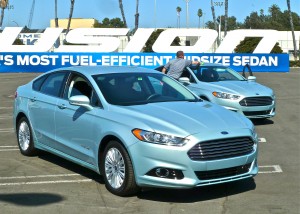
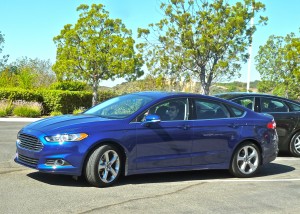
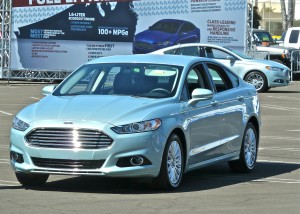
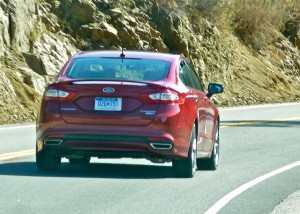
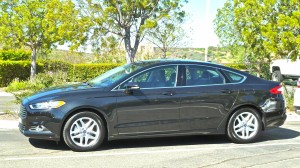
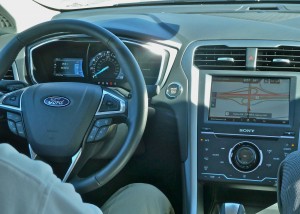
 John Gilbert is a lifetime Minnesotan and career journalist, specializing in cars and sports during and since spending 30 years at the Minneapolis Tribune, now the Star Tribune. More recently, he has continued translating the high-tech world of autos and sharing his passionate insights as a freelance writer/photographer/broadcaster. A member of the prestigious North American Car and Truck of the Year jury since 1993. John can be heard Monday-Friday from 9-11am on 610 KDAL(www.kdal610.com) on the "John Gilbert Show," and writes a column in the Duluth Reader.
John Gilbert is a lifetime Minnesotan and career journalist, specializing in cars and sports during and since spending 30 years at the Minneapolis Tribune, now the Star Tribune. More recently, he has continued translating the high-tech world of autos and sharing his passionate insights as a freelance writer/photographer/broadcaster. A member of the prestigious North American Car and Truck of the Year jury since 1993. John can be heard Monday-Friday from 9-11am on 610 KDAL(www.kdal610.com) on the "John Gilbert Show," and writes a column in the Duluth Reader.